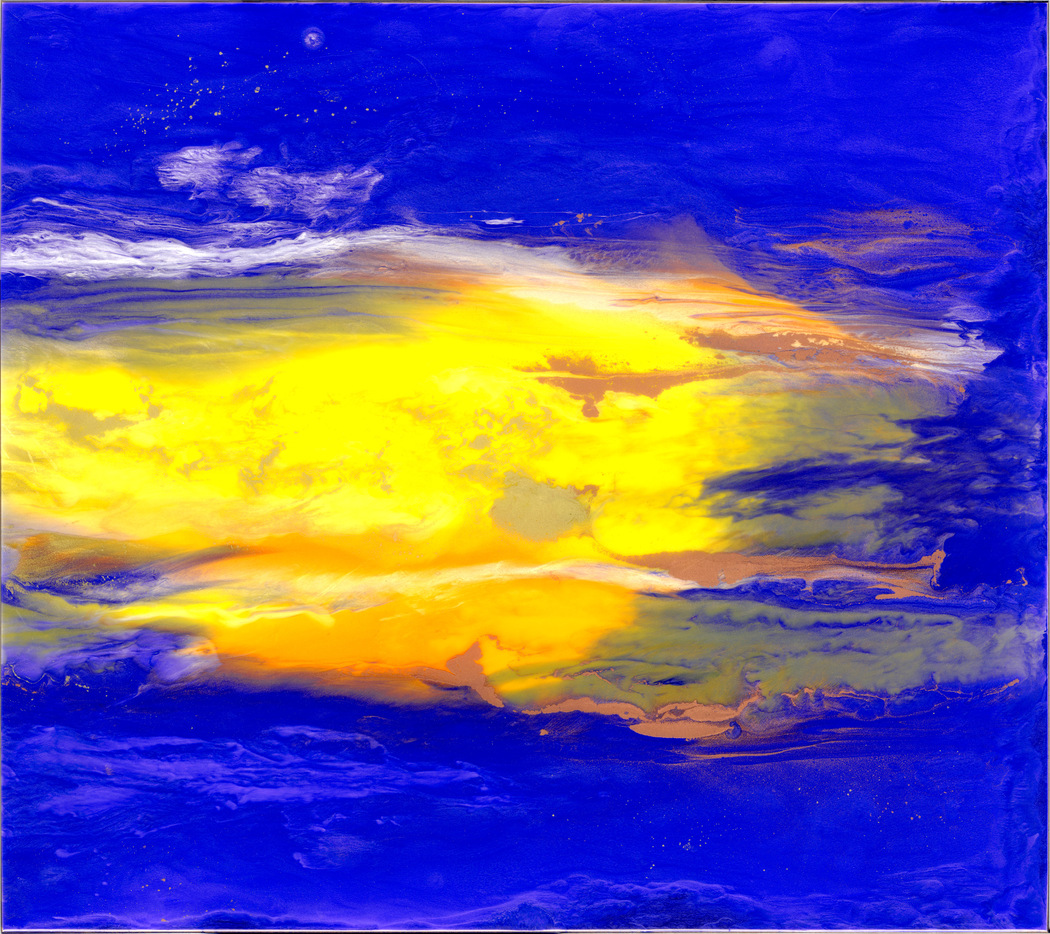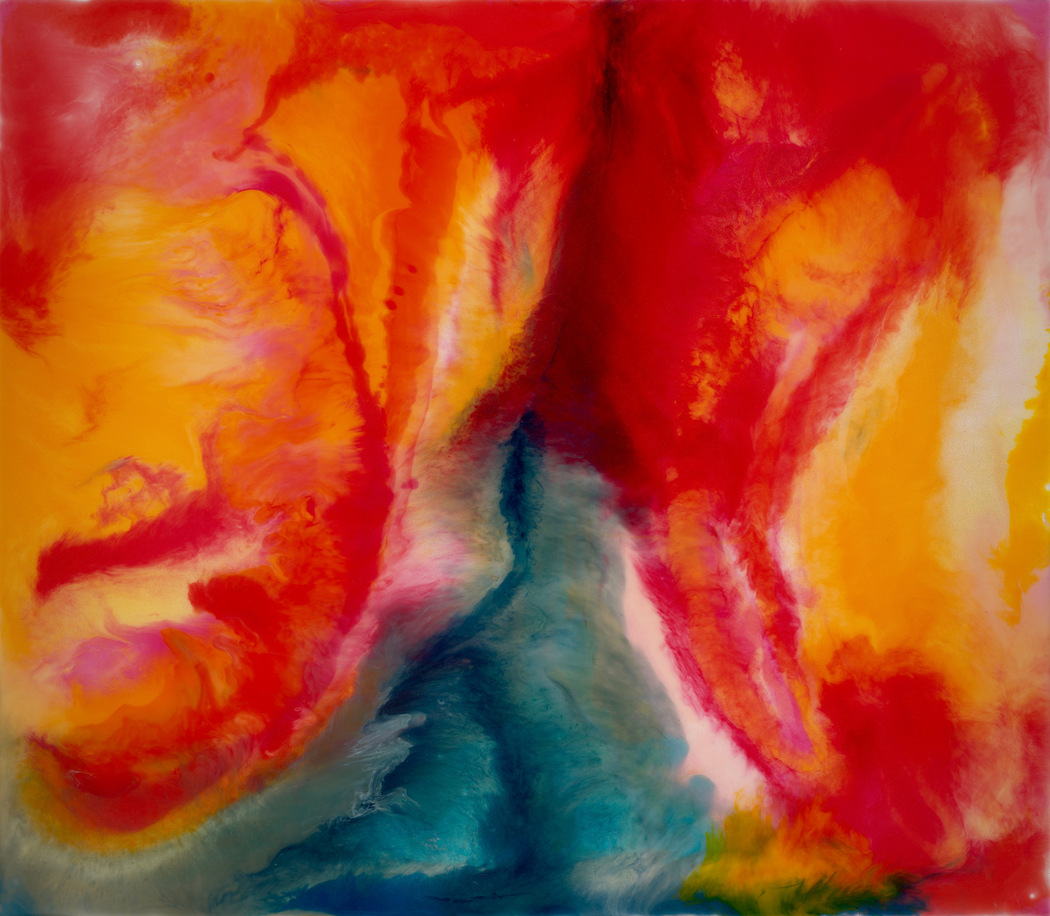Julia Poppy
Year of birth: 1990
Your education: Bachelor of Journalism
Describe your art in three words: Depth, emotion, individuality
Your discipline: Abstract art
Website | Instagram

Your work uses a unique technique involving epoxy resin and acrylics. Could you explain the process and how you developed this approach?
In fact, the idea of using epoxy resin with acrylic for artistic purposes was invented before me. It works similarly to oil — the material is the same, but the styles, directions, and application techniques vary.
For several years, I experimented in my studio, mixing colors and applying the resin in different ways to achieve the exact effect that would best express my artistic vision and become a fully-fledged stylistic technique.
My method involves first constructing an approximate composition, selecting the paints, calculating the resin’s curing time, and applying it at a specific angle — this way, the colors set in a particular manner without blending into each other. I also use my own signature technique of applying dispersed elements, which are seamlessly integrated into the overall composition of the painting at the final stage.
Instead of canvas, I use special MDF boards ranging from 60 cm to 2 meters in length, so creating a single piece takes quite a lot of time and physical effort.
In your artist statement, you mention exploring how emotions affect one’s perception of time and state of mind. What inspired you to delve into these themes?
This research is the result of my long-term observations. Most of us are familiar with the feeling that time moves differently depending on the situation. Time can stretch out, or on the contrary, it can be catastrophically scarce. For example, when we are with someone we love, it feels like there’s never enough time to “breathe them in,” while during routine tasks or while waiting for an important decision beyond our control, time drags on unbearably.
Often, even when we understand the nature of certain emotions, it can still be difficult—or even impossible—to contain them. We may want to always stay in control of our emotional state, but emotions have their own rules. It has always been important to me to learn how to respond calmly to irritants and, more broadly, to unpleasant things that happen to me. We cannot change other people, but we can strive to understand the essence of human actions.
It is precisely the ability to manage emotions that helps preserve inner balance and strength.
 Julia Poppy | Night life | 2024
Julia Poppy | Night life | 2024
How does working with resin, a material that requires letting go of control, influence your creative process and the final outcome of your artworks?
Since I experimented with this material for quite a long time and often ended up with completely different results than I expected, I realized something important for myself: there’s no need to rush, no matter how hopeless the situation may seem. The stronger the control, the more intense the resistance.
From my observations, I find the greatest joy in the results that came when I tried the least to control the process. This doesn’t mean everything should be left to chance, but a gentle relaxation, trust in your hands and the material—these are what help convey the intended image most effectively.
You describe your work as meditative. How does this meditative approach impact your daily life and artistic practice?
In today’s world, with its overloaded information field where we are constantly bombarded by stress and anxiety, there arises a need for regular reboots of our personal space.
As someone who is deeply sensitive to negativity, injustice, and other unpleasant aspects of life, I find it absolutely essential to retreat from time to time into my own serene world.
There, I shift my focus to the joy of living and simple pleasures, I admire the beauty of nature and feel grateful for the ability to slowly sink into a barely perceptible, gentle feeling of happiness…
My personal way of tuning into a positive frequency is a kind of meditation that helps me recharge, feel the wholeness of the planet, and sense myself rising above the weight of the world—allowing me to keep soaring lightly, both in life and in the process of creating my paintings.
 Julia Poppy | The Ultimate Pleasure | 2020
Julia Poppy | The Ultimate Pleasure | 2020
What do you hope viewers experience or feel when they engage with your abstract works?
The entire message of my artistic expression lies in helping people and, of course, in the deep desire to make this world a little kinder. I want the viewer to feel that the positive aspects of life ultimately always outweigh the negative ones.
Utopia may be unattainable, but everyone can contribute to it in their own way.
One of the most important aspects for me is conveying the positive energy that the painting radiates to the viewer. Of course, much depends on the viewer’s own sensitivity.
Nevertheless, if someone happens to be overwhelmed by sadness, anxiety, or some misfortune, then by looking at my painting, they might feel a bit of relief. They may remember that life contains vivid colors and gentle nuances.
Beyond the darkness, there is always light—and it can be seen, no matter how hard it might be at times.
Your works have been exhibited internationally, in places like Monaco, Madrid, and New York. How do different cultural contexts influence the reception of your art?
An interesting observation for me has been that, depending on the cultural context, gallerists and curators tend to favor different color palettes. For New York, the curators selected works from the Nightlife series, where a dynamic composition is combined with rich cobalt and electric blue tones.
In Monaco, the showcased works featured delicate light shades of lilac and sunny hues, with subtle golden shimmer. Meanwhile, Madrid opted for a bright red, passionate piece with a telling title — The Ultimate Pleasure!
Now, a group exhibition is being prepared in London with my participation, and the painting selected by the jury reflects the colors of London’s very own neighborhoods.
Still, despite these differences, I believe one of the most important functions of art is to bring people and countries together — to create a world where borders are merely symbolic, where human values come to the forefront, and where we all realize that Earth is our shared home.
You explore themes of emotional instability and transforming anxiety into constructive experiences. How do these themes reflect your personal journey or challenges?
Sometimes, our greatest enemy is ourselves. We resist and refuse to take action simply out of fear. Yes, circumstances can also be unfavorable, and it may feel as though we’ve lost all external support. Nevertheless, it’s essential to remember that any tension is an opportunity for growth—both mental and physical.
My personal journey has always been about battling emotions and anxiety. Since childhood, I’ve had to face criticism directed at me and often found myself misunderstood. This applied not only to my appearance and intellect but also to my creativity. Support was rare, so I had to deal with all my inner struggles on my own.
As an adult, especially after the age of thirty, emotional upheavals started to hit harder each time. I realized it was becoming unbearable to handle them alone—so I turned to professional psychologists for help. Ultimately, my experience taught me that the most reliable path is to truly listen to my inner voice—my intuition has always guided me in overcoming critical situations and transforming them into valuable skills.

Leave a Reply